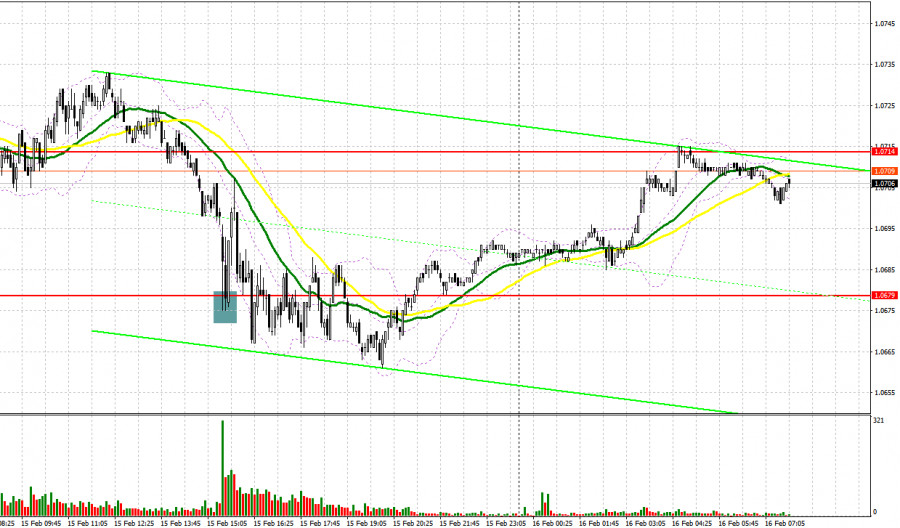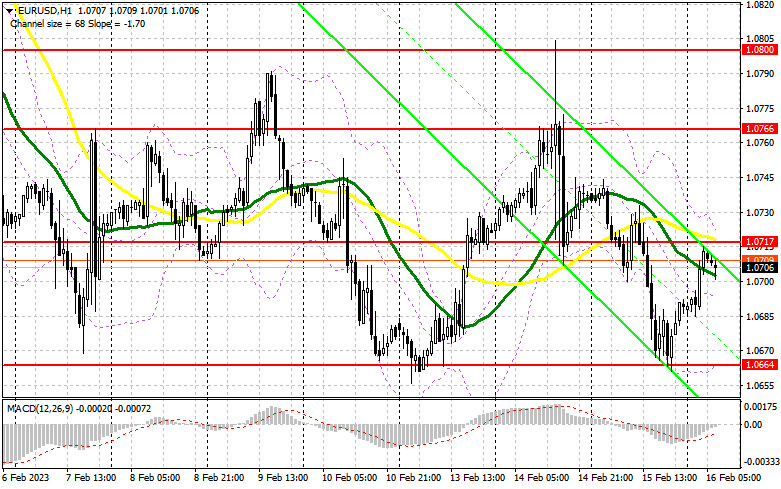
Yesterday, there was only one entry point. Now, let's look at the 5-minute chart and figure out what actually happened. In my morning article, I turned your attention to 1.0714 and recommended making decisions with this level in focus. As a decline to this level was rather blurry, it was impossible to identify entry points in long and short positions. Despite this, I did not revise the technical outlook for the afternoon. A sharp drop in the pair to 1.0679 after the release of US data gave an entry point into long positions. After a slight rebound by 20 pips, the pressure on the euro returned. There were no other entry points.

When to open long positions on EUR/USD:
The US dollar rose yesterday as US retail sales soared in January, beating expectations. It renewed fears that the Fed could stick to monetary tightening for a longer period of time. However, the euro may recover amid macroeconomic reports that are on tap today, namely Italy's foreign trade balance and the Economic Bulletin from the ECB. If the ECB makes optimistic predictions, the bulls could regain the upper hand. Apart from that, if ECB Executive Board members Fabio Panetta and Joachim Nagel deliver hawkish comments, it will help risky assets break through to weekly highs. If the pressure on the pair persists, which is quite likely in the current market conditions, one should pay attention to 1.0664 - the lower border of the sideways channel. The pair has already rebounded twice from this level. Only after a false breakout of 1.0664, it is better to go long. The price may grow to the resistance level of 1.0717 formed yesterday. A breakout and a downward retest of this level amid hawkish comments from ECB policymakers may generate a new entry point into long positions with a jump to 1.0766. However, the pair will hardly be able to rise above this level before the publication of important US reports. A breakout of 1.0766 will force bears to close their Stop Loss orders. It will give a buy signal with the prospect of moving up to 1.0800. At this level, I recommend locking in profits. If EUR/USD declines and buyers show no activity at 1.0664 in the morning, bulls will be unable to regain control. A breakout of this level will signal a resumption of the bearish trend. In this case, traders should shift their attention to the support level of 1.0601. Only a false breakout there will create new entry points into long positions. You could buy EUR/USD at a bounce from a low of 1.0565 or 1.0525, keeping in mind an upward intraday correction of 30-35 pips.
When to open short positions on EUR/USD:
It is better to sell the euro at 1.0717 - the resistance level formed yesterday. This level is also the middle of the sideways channel. Before opening short positions, make sure that large traders have entered the market. The bears should try to defend this level. A false breakout of this level in the morning will trigger a correction to 1.0664. A breakout and an upward retest of this level against the background of dovish rhetoric from ECB officials will give an additional sell signal with a decline to 1.0601. It will certainly strengthen bearish sentiment. A drop below this level will occur only amid upbeat US economic reports. It may trigger a stepper downward movement to 1. 0565. At this level, I recommend locking in profits. If EUR/USD climbs during the European session and bears show no energy at 1.0717, which is less likely, the bulls will try to regain control of the market. In this case, I advise you to postpone short positions until a false breakout of 1.0766. You could sell EUR/USD at a bounce from 1.0800, keeping in mind a downward intraday correction of 30-35 pips.

COT report
Due to a technical failure of the CFTC that has been going on for more than two weeks, new COT reports continue to be delayed. The most recent data was published on January 24.
The COT report for January 24 logged a rise in both short and long positions. Traders have significantly increased long positions following hawkish speeches of ECB policymakers. They are betting on further monetary tightening by the ECB and the Fed's dovish stance. The US regulator may reduce the pace of tightening for the second time in a row. Weak macro stats on the US economy, namely a drop in retail sales and a slowdown in inflation may force the central bank to take a pause in rate hikes to avoid any damage. This week, several central banks will hold their meetings. Their results will eventually determine the trajectory of the euro/dollar pair. According to the COT report, the long positions of the non-commercial group of traders increased by 9,464 to 237,743 while short positions advanced by 2,099 to 103,394. At the end of the week, the total non-commercial net position rose to 134,349 from 126,984. It appears investors believe in the upside potential of the euro. Nevertheless, they are waiting for more clues from central banks regarding interest rates. The weekly closing price grew to 1.0919 from 1.0833.
Indicators' signals:
Trading is carried out near the 30 and 50 daily moving averages, which indicates market equilibrium.
Moving averages
Note: The period and prices of moving averages are considered by the author on the H1 (1-hour) chart and differ from the general definition of the classic daily moving averages on the daily D1 chart.
Bollinger Bands
If EUR/USD rises, the indicator's upper border at 1.0717 will serve as resistance. In case of a decline, the indicator's lower border at 1.0664 will act as support.
Description of indicators
Moving average (moving average, determines the current trend by smoothing out volatility and noise). Period 50. It is marked yellow on the chart.Moving average (moving average, determines the current trend by smoothing out volatility and noise). Period 30. It is marked green on the chart.MACD indicator (Moving Average Convergence/Divergence - convergence/divergence of moving averages) Quick EMA period 12. Slow EMA period to 26. SMA period 9Bollinger Bands (Bollinger Bands). Period 20Non-commercial speculative traders, such as individual traders, hedge funds, and large institutions that use the futures market for speculative purposes and meet certain requirements.Long non-commercial positions represent the total long open position of non-commercial traders.Short non-commercial positions represent the total short open position of non-commercial traders.Total non-commercial net position is the difference between the short and long positions of non-commercial traders.